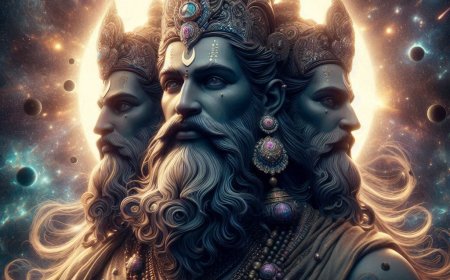Kalpataru Mythology, the sacred tree sanctified by the Gods.
In Hindu Mythology, there is a tree sanctified by the gods, believed to be a tree that can grant human wishes and is also considered a symbol of wealth, fertility, and purity.

The Mysteries and Wonders of the Universe Revealed through Mythological Tales
The mysteries and wonders of the universe have been unveiled through stories of mythology told by various civilizations. These mythological tales continue to be believed and cherished as a part of our culture to this day. In this article, we will delve into one such mythology: Kalpataru, a sacred tree sanctified by the gods. But before we proceed, what exactly is mythology? Mythology is a form of literary science that encompasses concepts related to the lives of gods and supernatural beings within a culture. Typically, these stories are set in a time when humans already exist and are linked to the history and origin of a place.
Kalpataru mythology is about a sacred tree believed to have been sanctified by the gods as a dwelling place for spirits. The term "Kalpataru" comes from the words "klp," meaning desire, and "taru," meaning tree, literally translating to a tree that fulfills all desires. According to Hindu mythology, the Kalpataru tree is said to have the ability to grant human wishes, bestowing wealth, fertility, and happiness. It is described as a large tree with broad branches covered in lush green foliage. Its dense leaves provide protection and refreshing shade to the creatures sheltered beneath its branches. It is also believed that every part of this tree possesses healing and life-giving energies.
Hindu legends recount that when the gods and demons united in their quest for the Ramayana, they gathered beneath the Kalpataru tree to discuss their plans, providing a comfortable meeting place.
The Kalpataru tree does not have a specific origin story, but in various reliefs, stories, and ornamentation, it is symbolized as a sanctified tree. Scholars speculate that this concept is related to the idea of the Mother Goddess. Ancient societies believed the "mother" represented fertility. The tree, in this context, resembles a mother figure. Additionally, there is the concept of the "upper world" and the "lower world." Between these two worlds stands the "middle world," symbolized by a tree, serving as a bridge between the two. According to Hindu mythology, the Kalpataru tree is one of the five sacred trees in the heaven of Lord Indra, offering hope. The other four are Mandara, Parijata, Samtana, Kalpataru, and Haricandana.
In Indian literature, the Kalpataru tree was particularly popular during the Gupta period, known for its advancements in science, mathematics, astronomy, religion, and philosophy. The Kalpataru symbol was used in various ornaments, often with diverse forms, including reliefs of intertwining leaves with interlocked tips. It served as jewelry and decoration for women in Alaka and as talismans made from tree branches for protecting childbirth and warding off enemies and evil spirits.
In Indonesia, the term Kalpataru is referred to as the Hayat tree. It can be found predominantly in the inscriptions left by King Mulawarman of the Kutai Kingdom, characterized by five main features: guardian animals as symbols of sanctity, flower arrangements as symbols of wealth, beads or pearls as symbols of fertility, umbrellas as symbols of purity, and birds or kinnaras (half-human, half-bird creatures)

Kinara - Kinari Carvings (Photo Source: Editorial Collection)
as symbols of tree guardians and life protectors. In modern times, Kalpataru has become synonymous with an honor or award given to individuals or groups for their efforts in preserving the environment in Indonesia, and June 5 is commemorated as World Environment Day.
Beyond its religious and symbolic aspects, Kalpataru plays a broader role in various aspects of life. It represents a deep philosophy of achieving goals and fulfilling desires, inspiring individuals to pursue ambition and prosperity in various fields. In art and design, Kalpataru is often found as an enchanting aesthetic element, conveying inspirational messages about determination and effort. The environment also finds meaning in Kalpataru, reminding us of the importance of preserving the natural world and the forests that sustain life. This concept can be applied in education, business, and career development, symbolizing the values of lifelong learning, corporate growth, or personal development. Thus, Kalpataru transcends religious boundaries, becoming a universal symbol of aspiration, prosperity, and growth in various everyday life contexts.
Kalpataru: The Tree of All Desires in Hindu Mythology, transcending time and space as a symbol of boundless potential and spiritual enlightenment. Its roots run deep in Hindu culture, reminding its followers of the power of belief, aspiration, and the fulfillment of deep desires. As we continue to navigate the complexities of life, Kalpataru serves as a timeless reminder that our deepest wishes and aspirations can bear fruit with dedication and the right faith.






























































